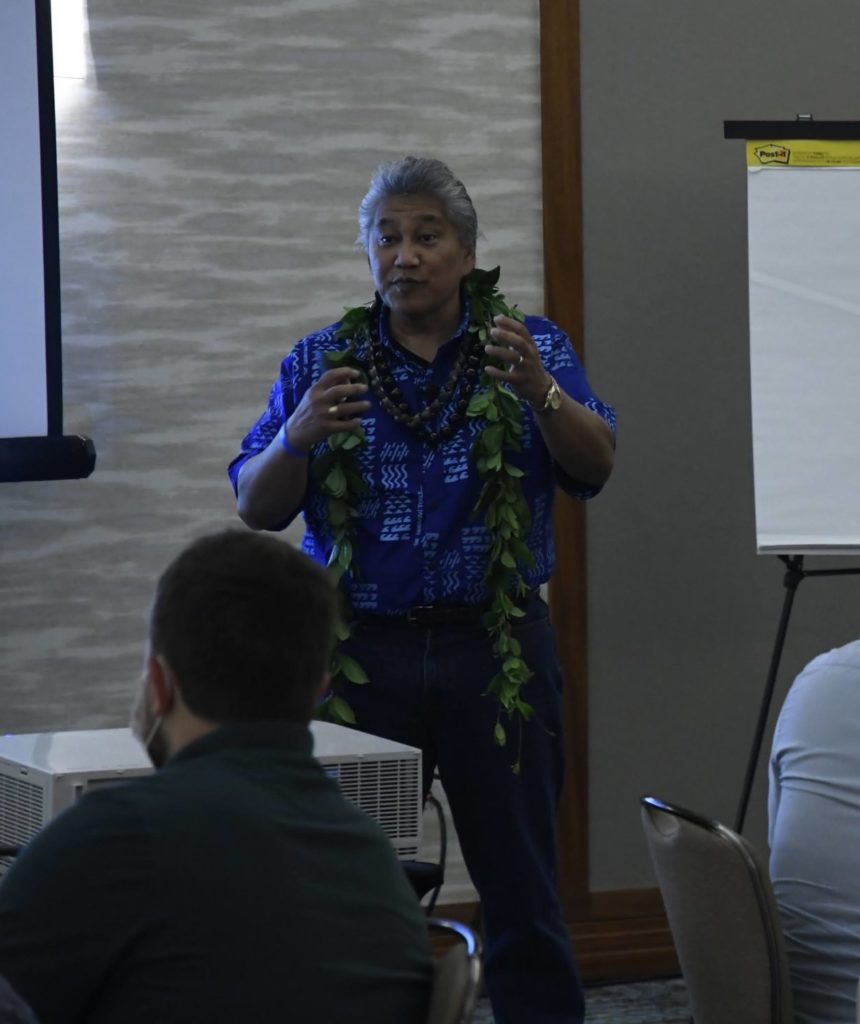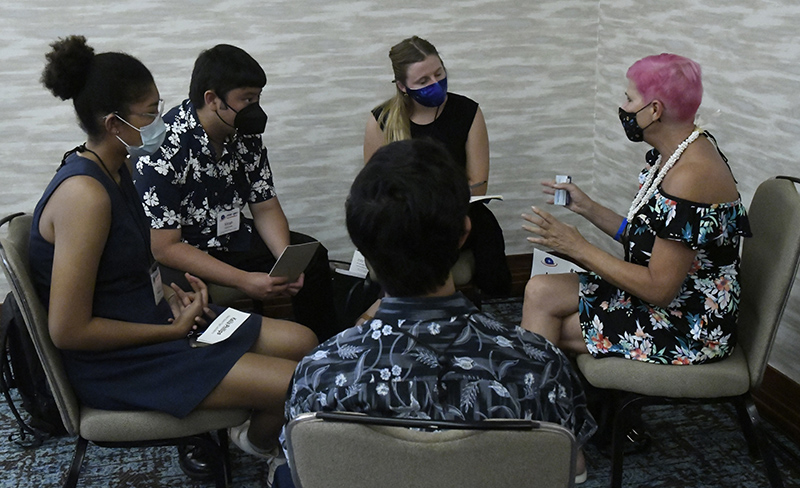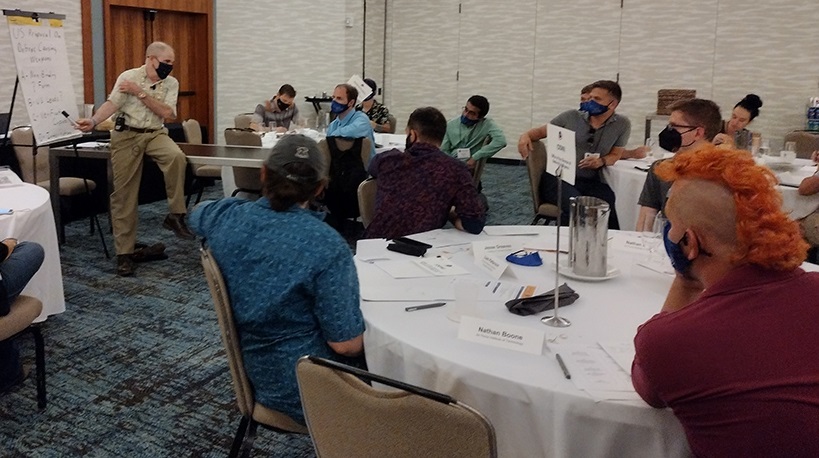The 4th annual EMER-GEN® Program returned to Maui September 12-14 with young professionals and students pursuing space careers excited to meet once again in-person after a year of virtual. A joint initiative of the Advanced Maui Optical and Space Surveillance Technologies (AMOS) Conference and the Space Generation Advisory Council (SGAC), the program focuses on fostering innovation and entrepreneurship among the cohort.
Throughout the program, which included three pre-event webinars, participants were challenged to hack and solve problems with critical-thinking exercises to create new opportunities for space-based technologies. Discussions ranged widely, from effective multi-cultural communication and leadership qualities to inter-agency cooperation for long-term sustainability of the space environment. A mentor session assisted with career choices and opportunities, and specialists in Space Situational Awareness (SSA), Space Traffic Management (STM), and Space Domain Awareness (SDA) presented short courses to upgrade technical skills and keep the cohort abreast of recent developments in these fields of special interest.
“MEDB was honored to provide a dialogue platform for the 36 young professionals who joined the 2021 EMER-GEN cohort,” said Sandy Ryan, Conference Director for MEDB. “This experience continues to provide a significant pathway into future careers.”
The event, held with Maui County approval, was focused on health and safety for all involved. All participants were checked for proof of vaccination or negative covid-test prior to arriving in Maui (if travelling interstate) OR within 3 days of the event for those local to Hawaii. Protocols included wearing of masks, social distancing and limiting the footprint of the event to the one venue.
Along with MEDB, three young professionals helped shape the program. Two representatives nominated by SGAC, Quentin Verspieren, Space Policy Researcher with the University of Tokyo, and Christine Dubbert, a Project Engineer with York Space Systems, were joined by Maui resident Micah Nishimoto, an undergraduate student of Aerospace Engineering at the University of Southern California.
“I have been involved with SGAC since 2019 and am one of their national points of contact for the United States,” said Dubbert. “We meet peers across the globe through the United Nations, have a chance to shape future policy, and see firsthand the way industry is going. EMER-GEN, in line with SGAC, fosters greater collaboration across the various sectors of the space industry and supports the continued development of a peaceful, inclusive, and global space community.”
Verspieren, who was unable to make the trip to Maui, noted, “The ability to conduct EMER-GEN in hybrid format with three online seminars followed by in-person activities allowed us to get the best of both approaches: great cohort dynamics with an opening to the world.”
Nishimoto added, “I was humbled to be part of the organizing team. EMER-GEN was a great opportunity to learn about space engineering, space policy, diversity, equity, and inclusion. Being born in Hawaii, I was introduced to Native Hawaiian values early on. I thoroughly enjoyed helping to plan the opening discussions about symbiotic relationships and the importance of working together.”
Lokahi – Lessons from the Reef

Ramsey Taum, Founder and President, Life Enhancement Institute of the Pacific, and Director, External Relations and Community Partnerships at the University of Hawaii School of Travel Industry Management spoke to the group on communication and diversity. Taum is recognized locally, nationally, and internationally for his transformational leadership in sustainability and integrating cultural place-based values into contemporary business models. He advocates team building, strategic partnerships, community brilliance and creative thinking.
“In Hawaii, sense of place is important: knowing where you are from, who you are, and where you are going,” said Taum. Those questions are important in all communication. The analogy of the reef shows us each part working in harmony. Often when we discuss diversity, the purpose of it is really to come together, in unity. Hence the cohort, coming from different cultures and nationalities, are here to work towards one goal.”
“By integrating sustainable Native Hawaiian cultural values and principles into contemporary business we can reframe, refocus and redefine complex situations, scenarios and problems. When we agree to disagree, with aloha, we find that we are truly one people.” concluded Taum.
“I welcomed the icebreaker that Mr. Taum and our team coordinated,” said Nishimoto, who collaborated with Taum to frame the presentation for the cohort. “It involved stones that everyone brought with them. This opportunity allowed us to convene and to transit from ‘me to we’. By placing our stones in one jar, telling our name and where we are from, we became a cohort. This transition granted us a chance to build common ground.”
Katlynn Vicuna, Hawaii Space Flight Laboratory, commented, “This was such a meaningful presentation. Even though I am from Hawaii, Mr. Taum helped me gain more insight into what ‘working together’ means, in my job and in my life.”
“This was a great presentation! recalled Rachit Bhatia, LeoLabs. “Listening to how to improve our actions, and then align our thinking to our actions, in our work and in our life, is vital. Mr. Taum gave a spiritual presentation, showing the aloha way is the way for the world. His wisdom and knowledge are inspirational. He shared how we can draw upon age-old wisdom and knowledge to find meaning in all things. His definition of the word Hawaii as Ha- (Life giving breath), wai-, (Life giving water), and i (Supreme life giver), was overwhelmingly impressive.”
Decision-Making under Uncertainty
Dave Baiocchi, a founding partner at Imaginative Futures, followed up with a presentation on innovation that integrated original, multidisciplinary research with technology and design trends to help stakeholders adapt in a rapidly changing world. He discussed how to work across the technology sectors to identify and articulate the factors that will affect the future of their decision-making.
Baiocchi emphasized, “It is vital in the space industry to accrue the skills and tools to work with business leaders in all the specialized fields. My goal is to offer suggestions to articulate and navigate the key inflection points, including economic, organizational, social, policy, and technological perspectives, that inform leadership decisions.”
Mentoring
Renowned space specialists from an array of fields related to SSA, SDA, and STM offered the cohort advice on educational opportunities and key programs to help advance their future careers, goals and milestones.
Mentors included: Alex Fielding, Privateer Space; Michael Gleason, The Aerospace Corporation; Jacqui Hoover, Hawaii Island Economic Development Board; Diane Howard, Sur L’Espace; Doug Loverro, Loverro Consulting, LLC; Daniel Porras, Secure World Foundation; David Mullins, Millennium – A Boeing Company; Moriba Jah, University of Texas at Austin; Mark Mullholland, Office of Space Commerce (MITRE), IPA AFRL; Stacie Williams, U.S. Space Force; and Laura Ulibarri, KBR.
Moriba Jah, University of Texas, Austin, reflected, “I think it is important to be a mentor because if the work we are doing is critical and important, we need continuity. At some point, the next generation takes over and if we have not prepared them then we risk not having that continuity. Mentors can reassure young professionals and students, they can validate, and they can provide other connections. There are many mentors who helped me along the way in my own career. Relationships matter.”
Maui-based Alex Fielding, Founder of Privateer Space, said, “The young people here today, focused on their education and careers in space, are going to be the builders of the future and the leaders of the companies. At this conference they are learning tools for building diplomacy by working together as teams. Being an EMER-GEN mentor allowed me to share my own expertise in an environment that might not happen anywhere else.”
“Mentoring the next generation is key to maintaining the space environment,” stated Diane Howard, Sur L’Espace. “Sharing my experience in space law and interagency work will assist the cohort in their specialized fields, helping them make better decisions in the future.”

Katlynn Vicuna noted, “Presently, I am not sure which career path I want to follow. It truly helped to talk to mentors from academia, military, and industry to broaden my skill set and my network. The mentor session was specifically valuable to me.”
Benigno Sandoval, Los Alamos National Laboratory commented, “Most EMER-GEN participants considered this the most valuable portion of the program and it is easy to see why. These mentors were all fantastic at conveying useful tidbits and intriguing stories from their careers, opening up about their perspectives while being genuinely enjoyable to interact with.”
University of Hawaii Student and intern at Hawaii Space Flight Laboratory (HSFL), Kalila Philips, said, “The mentors offered amazing advice that was personalized to my interests and goals. I find that with any topic, there is always more to learn. During these short talks, the mentors were able to exchange their knowledge and words of advice that I will carry with me throughout my career.”
“This is my third EMER-GEN,” shared Aaron Rosengren, University of California, San Diego. “The experience with the mentors has given me an opportunity to meet new people in the different areas of the space industry, especially those I would never meet as an aerospace engineering professor. Over the years, the mentors have provided me with a broader perspective of what is currently going on in the field, and the importance of how to approach different problems. Hearing different viewpoints are vital in the space industry”.
Kala’imoana Garcia, Hawaii Space Flight Laboratory, recalled, “The mentors opened so many new doors of opportunity for me because of their diverse backgrounds. The talent and creativity of the mentors and the information they presented were of such a high caliber. They gave me the confidence to be more open-minded about my future in the industry. In addition, the connections I made at EMER-GEN will provide opportunities to work on future projects with those working in other disciplines.”
Consensus Building – Interagency Consensus on International Treaty on Space Weapons
In a role-playing exercise, the cohort teams were called to the White House and assigned to different interagency groups to produce a consensus showing U.S. leadership on how to deal with kinetic weapons in space. In his role for the exercise as Deputy National Security Adviser, presenter Doug Loverro, (Loverro Consulting LLC and Former Deputy Assistant Secretary of Defense for Space Policy) was asked to deliver a proposal to President Biden to present to international partners at a G7 meeting. Space policy expert, Dr. Diane Howard, Principal at Sur L’Espace, provided background in a talk on The Hierarchy of Norms, that helped the cohort negotiate for the consensus proposal.
The agencies considered in this exercise were: Office of the Assistant Secretary for Space Policy, Department of Defense; NASA Orbital Debris Program Office; Office of Space Commerce, Department of Commerce; Office of the Director of National Intelligence; Office of Emerging Security Challenges, Bureau of Arms Control, Verification and Compliance, Department of State; Secure World Foundation; Satellite Industry Association

Loverro said, “Potential solutions are difficult to agree on. This exercise was designed to give the EMER-GEN cohort strategic advice and guidance on how to handle multiple elements of national security through establishing policy and guidance to assure the U.S. and its allies a safe space environment. The general cohort consensus was for a non-binding agreement for space debris mitigation assuring the right to protect the U.S., and for the international community to be included. Discussion and policy coordination between agencies is key for a U.S. resolution concerning space kinetic weapons and the hazardous debris they create.”
Diane Howard, Sur L’Espace, stated, “In our consensus we wanted to make sure that what we put forward to the President is something that is achievable and pragmatic. The legal framework of the law from an international standpoint is key to consensus building as it relates to U.S. space policy and space activities.”
“Although at first I was a little hesitant about how this activity would go, it turned into one of my favorite events,” said Sandoval. “I found myself getting caught up in the exciting discussion that unfolded as Mr. Loverro led us through the conversation that might occur when pressures are mounting and stakeholders have important but varied concerns and agendas.”
Garcia commented, “I learned so much about space law and policy that will be vital to my career. Being technical and wanting to build rockets and satellites, the importance of rules concerning space weaponry and debris is key. In the future, because of the growing problem, I will work on building satellites that can be more disposable and will burn up to prevent further accumulation of space trash.”
Hackathon
On the final day of EMER-GEN, the cohort worked in seven pre-assigned teams to develop a proposal that offered potential technological advancements in one of the following three areas: Space Logistics- Opportunities; Space Domain Awareness; and Commercial Technologies and Practices for the DoD.
The cohort were introduced to the Hackathon on the first of three pre-event webinars with a presentation by Tom Kubancik, Trusted Space Inc., with the goal for the young professionals to learn to understand the SBIR (Small Business Innovation Research) process and/or to build a business project.
“I congratulate every team,” said Kubancik at the conclusion of the program. “I was amazed walking around the room to see the comprehensive collaboration going on in terms of technical solutions, talent and experience. The level of work and creativity were of the highest caliber. I see this cohort working together to solve tough problems for the betterment of the industry.”
The morning session culminated in brief 7 minute pitch presentations by each team with judges listening for Significance of the problem being solved; Innovation; and Approach to the solution.
The judges were: Richard Chong, Air Force Research Laboratory (AFRL) Satellite Analysis Center (SATAC) and Maui High Performance Computing Center (MHPCC); Jacqui Hoover, Hawaii Island Economic Development Board; and Doug Nelson, Founder, President and CEO of Kinection.
Nelson said, “To echo what Tom said, every presentation was creative in their innovation to solve a certain problem. I felt that every presentation told a coherent story about an innovation that addressed an important industry challenge. The cohort came together as teams to identify a specific problem and go after it with an innovative solution.”
“I had the privilege of being a mentor and a judge,” emphasized Hoover. “I am so inspired with everyone in the cohort. This group has taken us in a transitional way to how to think versus what to think. The judges looking at their projects recognize many points of nexus—the cohort and the entire industry could easily work with each other on programs and innovations presented at this Hack-a-thon, and the AMOS Conference.”
Conclusion
The EMER-GEN cohort shared projects throughout the event and made lasting connections. Participants were also provided with technical short courses that served to expand technical job skills and support developments in several respective fields of interest.
“EMER-GEN is important,” emphasized Kubancik. “Each year the program enriches the cohort’s effectiveness to work in a global environment. Our industry is strengthened when we are inclusive and incorporate the ideas of every age group and nationality. This cohort is bright and smart. I learned a lot from them! MEDB has successfully evolved the EMER-GEN program over the years. They keep it fresh while staying true to its roots in terms of development of the young intelligent people in our industry.”
“Being part of the EMER-GEN planning committee was a once in a lifetime experience!” said Christine Dubbert who helped shape the hackathon portion of the program. “I had the opportunity to meet and network with my peers from across the industry and learn more about the broader space domain.”
Dubbert added, “The MEDB team were wonderful to work with! As a first time participant in EMER-GEN and AMOS, they really showed me the ropes and gave thoughtful feedback to my suggestions. I was so excited to meet the team in person and build on the relationships we had formed virtually.”
Katlynn Vicuna expressed, “This was my first official conference and I really enjoyed talking to all the different people from different backgrounds. I loved hearing their stories and experiences. Overall, I feel I accomplished a lot. I got to work on some confidence-building and technical issues, meet new friends, and bond further with my current colleagues. Being able to have casual conversation about my future career possibilities with the mentors and people already in those jobs was invaluable. I gained new insight into what I potentially can become!”
Kalila Philips said, “As an undergraduate engineering student, I often hear about very technical jobs and opportunities that I would like to know more about. Throughout this conference, I got to network with people who work in space policy, law, marketing and other specialized fields I am not familiar with. This was a key experience for my career.”
“EMER-GEN has furthered my career in so many ways,” concluded Aaron Rosengren. “Over the years, the people and contacts I made by participating in the conference remain priceless.”
Harry Krantz, University of Arizona Steward Observatory, added, “From beginning to end, EMER-GEN was a great experience. I really appreciate MEDB’s hospitality. Their team were not just the presenter and host; they really got involved in all aspects of our topics and sessions. Thank you MEDB!”
The 2021 EMER-GEN Program was supported by Advertising Partner, Millennium Space Systems; GEO Sponsor, Privateer Space; and LEO Sponsors a.i. solutions and Trusted Space.
